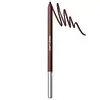Haus Labs By Lady Gaga Optic Intensity Eco Eyeliner Versus Makeup by Mario Master Pigment Pro Pencil
What's inside
What's inside
 Key Ingredients
Key Ingredients

 Benefits
Benefits

 Concerns
Concerns

 Ingredients Side-by-side
Ingredients Side-by-side

Isododecane
EmollientSynthetic Wax
AbrasiveTrimethylsiloxysilicate
EmollientDimethicone
EmollientPolybutene
Synthetic Fluorphlogopite
Argania Spinosa Kernel Oil
EmollientTocopherol
AntioxidantCaprylic/Capric Triglyceride
MaskingPolyglyceryl-4 Diisostearate/Polyhydroxystearate/Sebacate
EmulsifyingStearalkonium Hectorite
Gel FormingKaolin
AbrasiveMagnesium Oxide
AbsorbentAlumina
AbrasivePropylene Carbonate
SolventCI 77491
Cosmetic ColorantCI 77742
Cosmetic ColorantIsododecane, Synthetic Wax, Trimethylsiloxysilicate, Dimethicone, Polybutene, Synthetic Fluorphlogopite, Argania Spinosa Kernel Oil, Tocopherol, Caprylic/Capric Triglyceride, Polyglyceryl-4 Diisostearate/Polyhydroxystearate/Sebacate, Stearalkonium Hectorite, Kaolin, Magnesium Oxide, Alumina, Propylene Carbonate, CI 77491, CI 77742
Isododecane
EmollientTrimethylsiloxysilicate
EmollientSynthetic Wax
AbrasivePolymethyl Methacrylate
Polyethylene
AbrasiveCaprylyl Methicone
Skin ConditioningDiisostearyl Malate
EmollientSynthetic Fluorphlogopite
Stearoxymethicone/Dimethicone Copolymer
EmollientCopernicia Cerifera Wax
Polymethylsilsesquioxane
Disteardimonium Hectorite
StabilisingCaprylic/Capric Triglyceride
MaskingPolyhydroxystearic Acid
EmulsifyingCera Microcristallina
Emulsion StabilisingLecithin
EmollientPropylene Carbonate
SolventIsostearic Acid
CleansingPolyglyceryl-3 Polyricinoleate
EmulsifyingTocopherol
AntioxidantAscorbyl Palmitate
AntioxidantPentaerythrityl Tetra-Di-T-Butyl Hydroxyhydrocinnamate
AntioxidantCyclopentasiloxane
EmollientParfum
MaskingCopernicia Cerifera Cera
EmollientIsododecane, Trimethylsiloxysilicate, Synthetic Wax, Polymethyl Methacrylate, Polyethylene, Caprylyl Methicone, Diisostearyl Malate, Synthetic Fluorphlogopite, Stearoxymethicone/Dimethicone Copolymer, Copernicia Cerifera Wax, Polymethylsilsesquioxane, Disteardimonium Hectorite, Caprylic/Capric Triglyceride, Polyhydroxystearic Acid, Cera Microcristallina, Lecithin, Propylene Carbonate, Isostearic Acid, Polyglyceryl-3 Polyricinoleate, Tocopherol, Ascorbyl Palmitate, Pentaerythrityl Tetra-Di-T-Butyl Hydroxyhydrocinnamate, Cyclopentasiloxane, Parfum, Copernicia Cerifera Cera
Ingredients Explained
These ingredients are found in both products.
Ingredients higher up in an ingredient list are typically present in a larger amount.
This ingredient is an emollient, solvent, and texture enhancer. It is considered a skin-softener by helping the skin prevent moisture loss.
It helps thicken a product's formula and makes it easier to spread by dissolving clumping compounds.
Caprylic Triglyceride is made by combining glycerin with coconut oil, forming a clear liquid.
While there is an assumption Caprylic Triglyceride can clog pores due to it being derived from coconut oil, there is no research supporting this.
Learn more about Caprylic/Capric TriglycerideIsododecane is a fragrance, emollient, and solvent.
As an emollient, it helps your skin stay soft and hydrated. Emollients help trap moisture into your skin.
Isododecane's role as a solvent makes it a great texture enhancer. It spreads smoothly on skin and does not leave a sticky feeling behind. Isododecane also helps prevent color transfer in makeup products.
Isododecane is not absorbed into skin.
Learn more about IsododecaneThis ingredient is a solvent. It helps dissolve active ingredients and alter the texture of products.
Propylene Carbonate is commonly used in makeup and with clay, such as montmorillonite or bentonite.
Studies show this ingredient to be safe for cosmetics. When it is undiluted, it can cause skin irritation. (It is always diluted in skincare and makeup). This ingredient is water-soluble.
Propylene Carbonate is created from propylene glycol and carbonic acid.
Learn more about Propylene CarbonateSynthetic Fluorphlogopite is the synthethic version of mica. It consists of fluorine, aluminum and silicate.
Synthetic Fluorphlogopite is used to add volume to products.
It is considered non-irritating on the skin.
Learn more about Synthetic FluorphlogopiteSynthetic Wax is created from fossil fuels such as natural gas. It is used to enhance texture, adjust pH, and as an occlusive.
It may also be used as an abrasive ingredient to exfoliate the skin.
Synthetic Wax may not be fungal acne safe.
Learn more about Synthetic WaxTocopherol (also known as Vitamin E) is a common antioxidant used to help protect the skin from free-radicals and strengthen the skin barrier. It's also fat soluble - this means our skin is great at absorbing it.
Vitamin E also helps keep your natural skin lipids healthy. Your lipid skin barrier naturally consists of lipids, ceramides, and fatty acids. Vitamin E offers extra protection for your skin’s lipid barrier, keeping your skin healthy and nourished.
Another benefit is a bit of UV protection. Vitamin E helps reduce the damage caused by UVB rays. (It should not replace your sunscreen). Combining it with Vitamin C can decrease sunburned cells and hyperpigmentation after UV exposure.
You might have noticed Vitamin E + C often paired together. This is because it is great at stabilizing Vitamin C. Using the two together helps increase the effectiveness of both ingredients.
There are often claims that Vitamin E can reduce/prevent scarring, but these claims haven't been confirmed by scientific research.
Learn more about TocopherolThis silicone is an emollient. Emollients create a thin film on the skin to prevent moisture from escaping.
It is not soluble in water and helps increase water-resistance in products.
According to a manufacturer, it can blend seamlessly with silicone oils, such as Cyclopentasiloxane.
Learn more about Trimethylsiloxysilicate